
Live Theatre - Show Boat
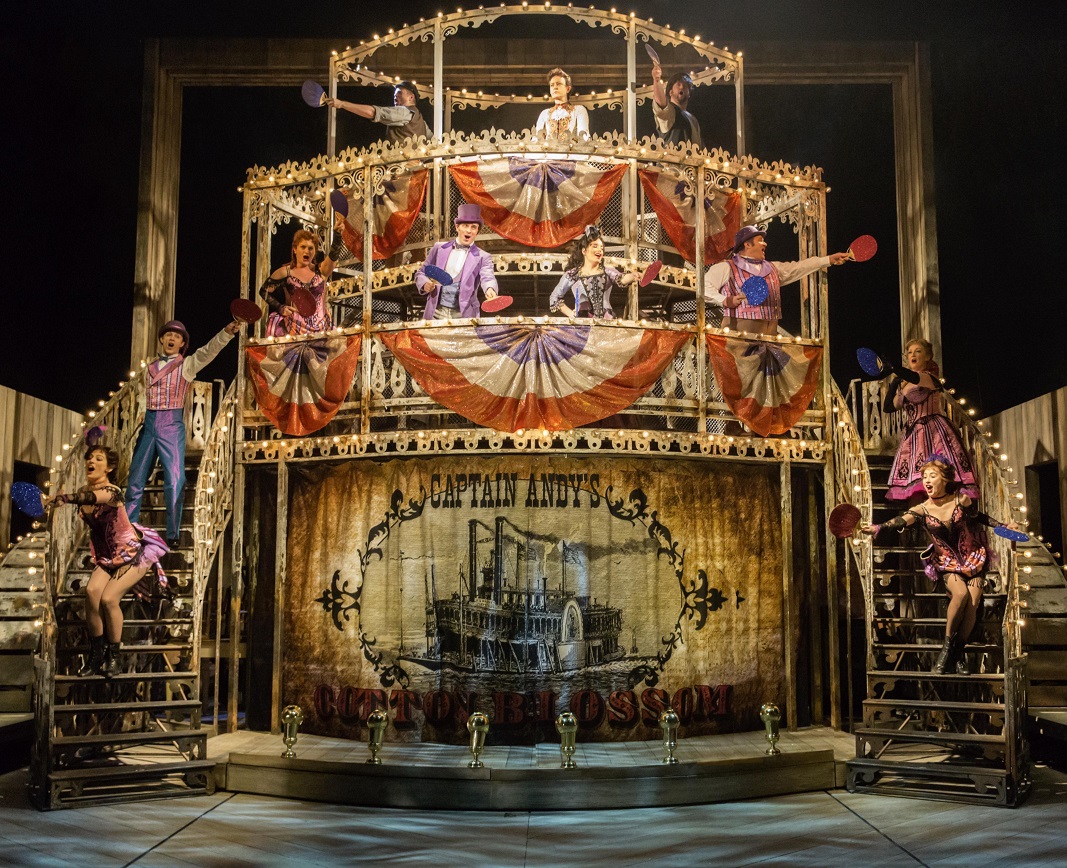
This stage version of SHOW BOAT debuted in late 2015 at the Crucible Theatre in Sheffield, England.
The trailer on YouTube demonstrates that this version was imaginative and "Hell for Leather" in style. Much more adventurous than the versions I've seen here in the U.S. The choreography resembles the calisthenics we all did in gym class.
Notice that the steamboat graphic on the stage curtain at the bottom of the picture is the same one we have in 3rd position on ILLUSTRATIONS 26 that I described as looking like it was done in pen and ink by the French illustrator Gustave Doré Scroll down to the bottom of this page to see that image and the caption I wrote. I located the graphic on the La Crosse site. It is possible that the art director for the Sheffield SHOW BOAT saw that "Doré" style graphic on steamboats.com and decided it would be perfect for the "wild and crazy" production that the Brits put on last year. Wish they'd bring that production to the U.S.
youtube.com Show Boat trailer
youtube.com The Making of Show Boat
Sheffield Theatres
Published on Dec 23, 2015
See the critically acclaimed Show Boat at the Crucible Theatre, Sheffield until Saturday 23 January.
To book go to sheffieldtheatres.co.uk or call the Box Office on 0114 249 6000.
Theatre review
telegraph.co.uk
Telegraph
Show Boat, Sheffield Crucible, review: 'something special'
Claire Allfree
17 DECEMBER 2015 • 12:16PM
Oh, how Sheffield Theatres will miss Daniel Evans. The outgoing artistic director, recently announced as the new head of Chichester Festival Theatre, has an assured reputation for copper-bottomed productions of classic musicals. But this revival of Jerome Kern and Oscar Hammerstein's lesser performed 1927 work is, even by his standards, something special.
It was a radical piece for its time. Based on Edna Ferber's novel about the tumultuous lives of a group of performers aboard the Mississippi show boat Cotton Blossom, it combines a panoramic snapshot of a changing America with detailed close-ups of personal hardship.
Spanning several decades from the late 1800s, it tackles racism, alcoholism, women's rights, gambling and the dawn of modernity. These were rare subjects back then for musical theatre, and in that great American musical tradition, Show Boat effortlessly views them through the telescoping lens of show business itself.
Kern's score is sublime, a groundbreaking mix of high opera and popular show tunes. Under the direction here of musical supervisor David White, every sound is lush, sonorous and extravagantly beautiful. Indeed, Show Boat is waterlogged with feeling.
Lez Brotherston's set, which combines wooden board walks with the light-bedecked bow of the Cotton Blossom, provides a clean backdrop to some richly explored performances. Racial tension simmers everywhere, from the bitter chorus of opening song, Cotton Blossom - "coloured folks work while white folks play" - to use of the N-word by a belligerent white man as he manhandles the sweating black stevedores. Most powerfully of all, Emmanuel Kojo's Joe, one of the black shiphands, lends Show Boat's most famous song, Ol' Man River, a magnificent note of plangent fatalism. It is a note that, through the song's repeated refrain, throbs throughout the show like a sorrowful heartbeat.
The singing is exquisite. Rebecca Trehearn's Julie, forced to end her career on the Cotton Blossom when it's revealed that she is half negro and thus guilty of inter racial marriage, lends a gorgeously deep, oaky quality to the musical's second big musical moment, Can't Help Lovin' Dat Man.
Gina Beck's Magnolia, who marries Michael Xavier's dashing but tormented Gaylord only to be abandoned by him years later in Chicago because of his gambling debts, and who transforms from pink cheeked innocent to powerfully assured grown woman, brings the house down with After The Ball. Sandra Marvin's Queenie, meanwhile, sings Mis'ry's Comin' Aroun' as though she possesses a sadness as old and deep as the river itself. Hammerstein's songs are mainly concerned with the subject of love but almost every note here articulates a deeper emotional subtext of regret and yearning, and as the show progresses, a terrible awareness of time passing.
There's some terrific character work from Allan Corduner as Captain Hawks who affectionately squabbles with his hatchet-faced wife Parthy, while Danny Collins and Alex Young inject plenty of wit as a couple of ghastly show biz wannabes.
Alistair David's slick choreography is beautifully deployed, too, no less so than during a racially charged dance "stand off" aboard the Cotton Blossom. Evans marshals what can become a rather choppy plot with fast, dream -like fluidity, ripping through the passing years in the second half with evocative use of projected newspaper headlines and finding in the show's final scenes a heart-aching note of redemption.
This is a terrific production, full of seamlessly integrated colour and detail. It is the kind of show that leaves you feeling choked, shivery and on an absolute high.
Until Jan 23. Tickets: 0114 249 6000; sheffieldtheatres.co.uk
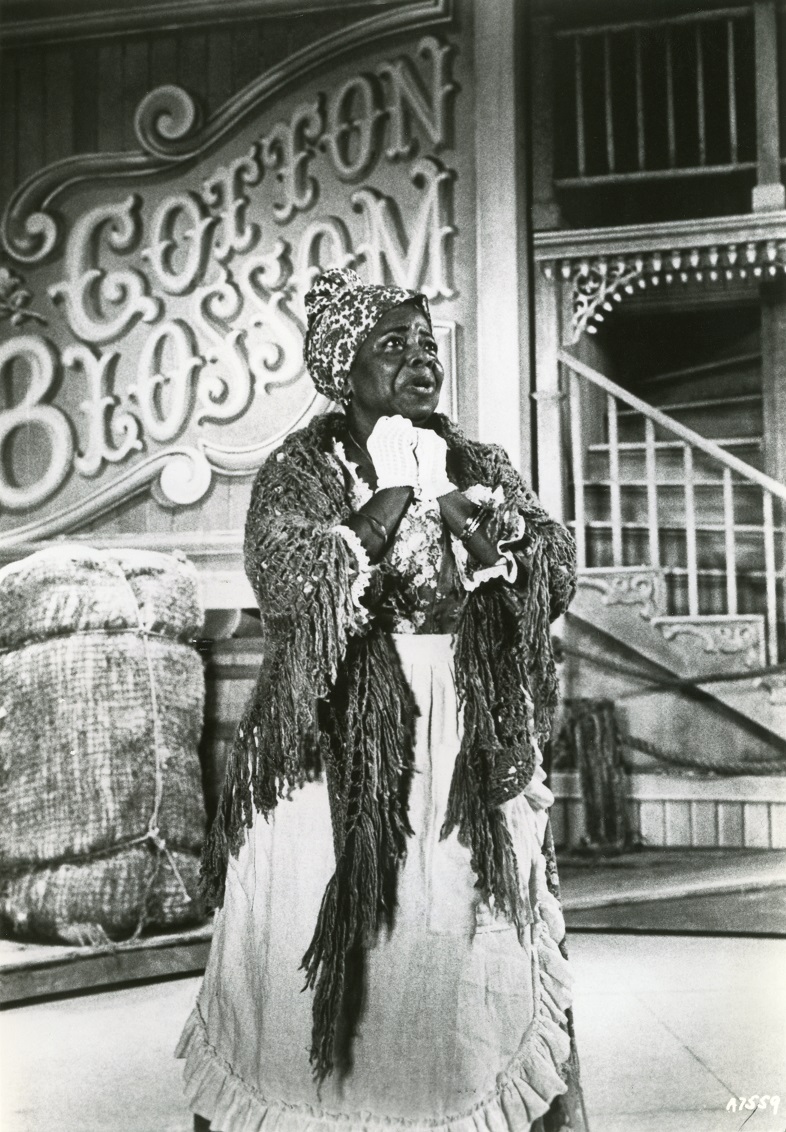
Butterfly McQueen as "Queenie" on the stage set for SHOW BOAT's "Cotton Blossom" in Minneapolis, Minnesota 1979.
October 31 1979
Star Tribune
Minneapolis, Minnesota
68 year old actress Butterfly McQueen is in Minneapolis for the part of Queenie in SHOW BOAT at the Orpheum Theatre, She still flutters, still talks in the high pitched voice that characterized her performance as Scarlett O'Hara's maid Prissy in GONE WITH THE WIND. Talking rapidly and going off on different tangents, McQueen at one point characterized Prissy as "silly" but admitted that the character was still her favorite role.
Below are excerpts from McQueen's imdb online biography: IMDB
Thelma McQueen (1911-1995) attended public school in Augusta, Georgia and graduated from high school in Long Island, New York. She studied dance with Katherine Dunham, Geoffrey Holder, and Janet Collins. She danced with the Venezuela Jones Negro Youth Group. The "Butterfly" stage name, which does describe her constantly moving arms, actually derives from dancing the "Butterfly Ballet" in a 1935 production of "A Midsummer Night's Dream". Her stage debut was in "Brown Sugar," directed by George Abbott for whom she did several other stage shows. In 1939 she appeared as the shop girls' assistant Lulu in The Women (1939) and in her most famous role, the irresponsible, whiny Prissy for Gone with the Wind (1939) whose signature line of dialogue was spoken when Prissy admitted that she had no experience as a midwife while Melanie Wilkes' was giving birth to a baby during the siege of Atlanta, Georgia. Prissy proclaimed: "Oh, Miss Scarlett, I don't know nothin' 'bout birthin' no babies").
Two other notable appearances among her string of silly maid parts were in Flame of the Barbary Coast (1945) and Mildred Pierce (1945). From 1947 to 1951, she was a regular on the radio show "Beulah" and then in the TV version 1950-52. In 1986 McQueen played the role of a blind slave in Part 1 of a PBS production of Mark Twain's Adventures of Huckleberry Finn.
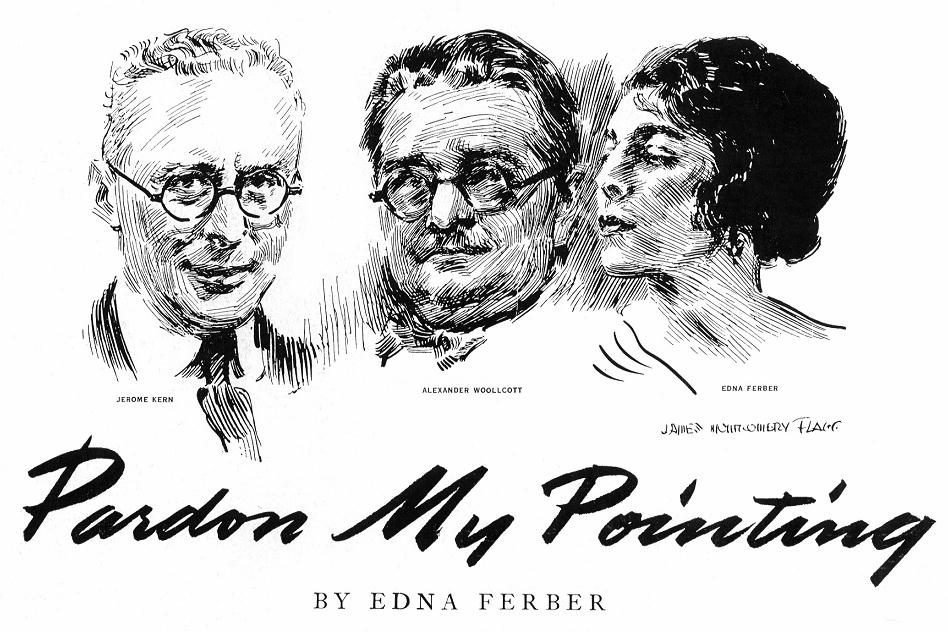
Show Boat article by Ferber in STAGE magazine 1938
Act 1 (Scene 2)
STAGE magazine August 1938
Pages 31 - 34
"Pardon my Pointing" by Edna Ferber
The author of Show Boat sings a sentimental Southern song, in which she remembers how the musical came about. In which she also calls our attention to the fact that Mr. Kern wrote a score worthy of the Metropolitan, even if he did write it in the American language.
Though I say it who shouldn't, I confess to being one of those thousands whose eyes grow dreamy and whose mouth is wreathed in wistful smiles whenever the orchestra - any orchestra - plays "Ol' Man River."
I've heard it played in the bar of the King David Hotel in Jerusalem, at Le Pré Catelan in the Paris Bois, at the Savoy in London (we writers get around).
Certainly I must have heard the score of Show Boat played a thousand times. I never have tired of it.
This, truthfully, is what is known in Tin Pan Alley as a song plug. I didn't write the music or the lyrics of the musical play entitled Show Boat.
I just happen to think that when Jerome Kern wrote the Show Boat score he achieved the most beautiful and important light-opera music that has ever been written in America.
And I consider Oscar Hammerstein's lyric to Ol' Man River to be powerful, native, tragic, and true.
It was Alexander Woollcott who acted as "shadchen" (Yiddish for"matchmaker") in the marriage between the novel entitled "Show Boat" and the music of Jerome Kern.
The happy union brought forth the musical play presented by Florenz Ziegfeld at the Ziegfeld Theatre in 1927.
Since that time, eleven years ago, there never has been a week when Show Boat was not being performed somewhere-on the stage, on the screen, over the radio.
It was Jerome Kern's idea - having read the book - that a play with music could be made from the story. We never had met.
One night I went to a first night with Alexander Woollcott ("olav hasholem" - Yiddish for "Mat May Peace be Upon Him") I think we saw Fred Stone and his family in "Stepping Stones" at the Globe Theatre.
After the first act we drifted out to the lobby and my courtly escort bounded off to talk with someone else, leaving me to my own devices, of which I had none.
A pixie-looking little man with the most winning smile in the world, and partially eclipsed by large thick spectacles, now fought his way through the lobby throng toward Woollcott.
He said (I later was told): "Look, Aleck, I hear you know Edna Ferber I wonder if you'll kind of fix it for me to meet her sometime soon. I want to talk to her about letting me make a musical from her Show Boat. Can you arrange an introduction, or a meeting or something?"
Mr. Woollcott, with a dreadful relish for the dramatic plum which had this fallen into his lap (if any), said, musingly, "M-m-m, well, I think I can just arrange it if I play my cards right."
"Thanks," said Kern. "Thanks awfully, Aleck, I'll be -----."
Woollcott now raised his voice to a bellow: "Ferber ! Hi, Ferber ! Come on over here a minute." Then, "This is Jerome Kern. Edna Ferber."
Well, folks, that is how your grandm ------- I mean, as the writing of the play proceeded (and its ups and downs were even more heartbreaking than those of most musical plays) I heard bits and pieces of the score.
Once or twice everything was seemingly abandoned because Ziegfeld said he couldn't produce the play. Almost a year went by.
I had heard "Can't Help Lovin' Dat Man" with its love-bemused lyric: "Fish gotta swim, birds gotta fly, I gotta love one man till I die. Can't help lovin' dat man of mine."
I had melted under the bewitching strains of "Make Believe," and of "Why Do I Love You?," and to Gaylord Ravenal's careless insolent gambler's song.
But then Jerry Kern appeared at my apartment late one afternoon with a strange look of quiet exultation in his eyes.
He sat down at the piano. He doesn't play the piano particularly well and his singing voice, though true, is negligible. He played and sang "Ol' Man River."
The music mounted, mounted and I give you my word my hair stood on end, the tears came to my eyes, I breathed like a heroine in a melodrama. This was great music.
This was music that would outlast Jerome Kern's day and mine. I never have heard it since without that emotional surge.
When Show Boat was revived at the Casino Theatre in New York just four years after its original production I saw a New York first-night audience, after Paul Robson's singing of "Ol' Man River," shout and cheer and behave generally as I've never seen an audience behave in any theatre in all my years of play going.
Of all the songs in all the shows none is cherished with more heart and soul and sung with more feeling than "Ol' Man River. . ."
If Carmen is Spain, and if Louise and Bohème are France, then Show Boat is legitimate American opera and I'd like to see it produced at the Metropolitan, as it should be.
I'd like to hear that Metropolitan orchestra tear loose with "Ol' Man River."
I'd like to hear Grace Moore or Lily Pons sing Magnolia, and Martinelli do Cap'n Andy, and Paul Robson sing Joe, Lawrence Tibbett sing the dashing Gaylord Ravenal, and Gladys Swarthout as Julie.
That would be stirring and glamorous and true American opera, as it should be sung and played. And I'll bet anything you like that you'd see no stuffed-shirt husbands asleep in the red plush boxes that opening night.
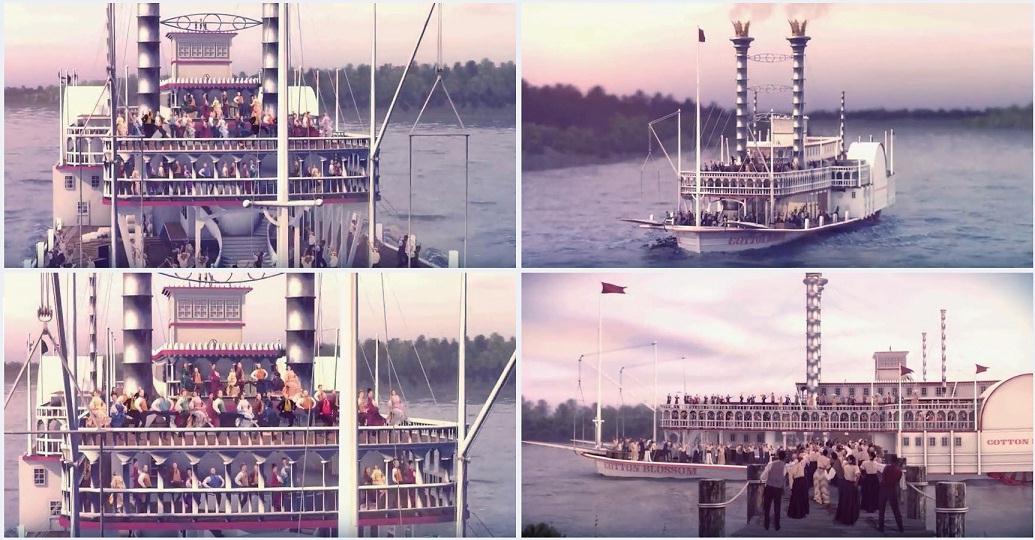
Show Boat Houston Grand Opera
4 frame captures of a digital "Cotton Blossom" steamboat/showboat that appears to have been based on kits of the ROB'T E. LEE which all featured a row of windows in the front of the pilot house. There weren't any windows on the front of those early pilot house, the half were wide open with adjustable "visor" along the top to ward of sunlight in the pilot's eyes. Windows would have drastically reduced visibility. These frames are from a promotional ad broadcast in Texas on YouTube for a 2013 Houston Grand opera production of Jerome Kern's SHOW BOAT
The review in Houston's Culture Map on 19 January 2013 gave this production a withering review:
"Houston Grand Opera's Show Boat is a rudderless ship:Uninspired, unintelligible & strangely viewless"
By Theodore Bale
houston.culturemap.com
Show Boat
Houston Grand Opera
Youtube
January 18 - February 9, 2013
The story follows the theatrical family of the Cotton Blossom as it sails the Mississippi providing musical entertainment along the way. A sophisticated story that dealt honestly with conflict and prejudice, its soaring melodies and lush orchestrations separated Show Boat from the lightweight entertainments that were standard on Broadway in the '20s, and make it an enduring work of American musical art today.
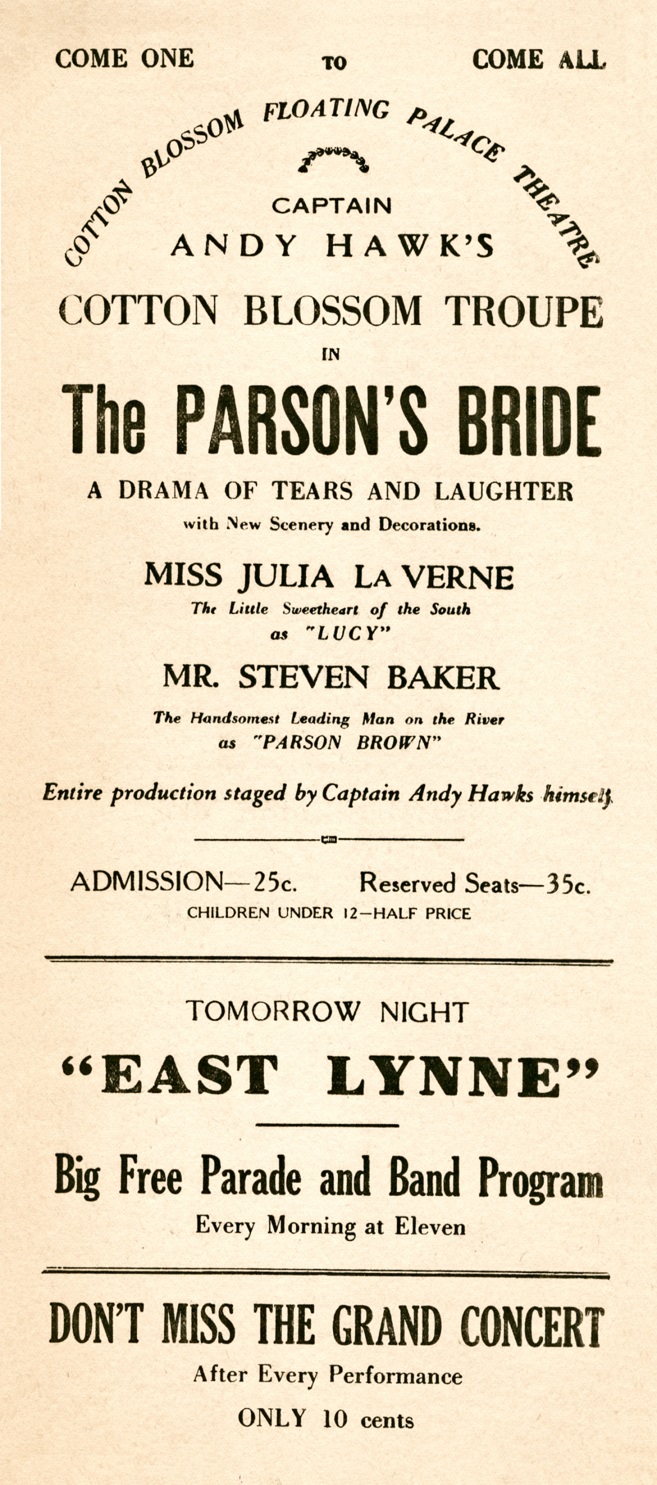
"The Parson's Bride" promotional bill enclosed in the original programs for SHOW BOAT
This mock up of a promotional bill for the showboat COTTON BLOSSOM's upcoming engagements was folded and enclosed as a bonus inside the programs of audience members who attended the original opening night of SHOW BOAT on December 27th , 1927 at the Ziegfeld Theatre, in New York, City. The play's run continued at this venue until May 4, 1929.
THE PARSON'S BRIDE was the play that was supposed to be performed within the fictional scenario of the musical SHOW BOAT with Julia La Verne as the leading lady who had "passed for white" although her Mother was black and her Father white. "Julie" as she is called in the dialogue is married to her white leading man Steven Baker.
Julie and Steven are ordered by the Sheriff at Natchez to leave the company of Andy Hawks' COTTON BLOSSOM for breaking Southern miscegenation laws forbidding the marriage of whites with blacks. After Julie and Steven leave, Andy Hawks replaces Julie with his own daughter Magnolia replaces Julie and Steven Baker is replaced by the itinerant gambler Gaylord Ravenal.
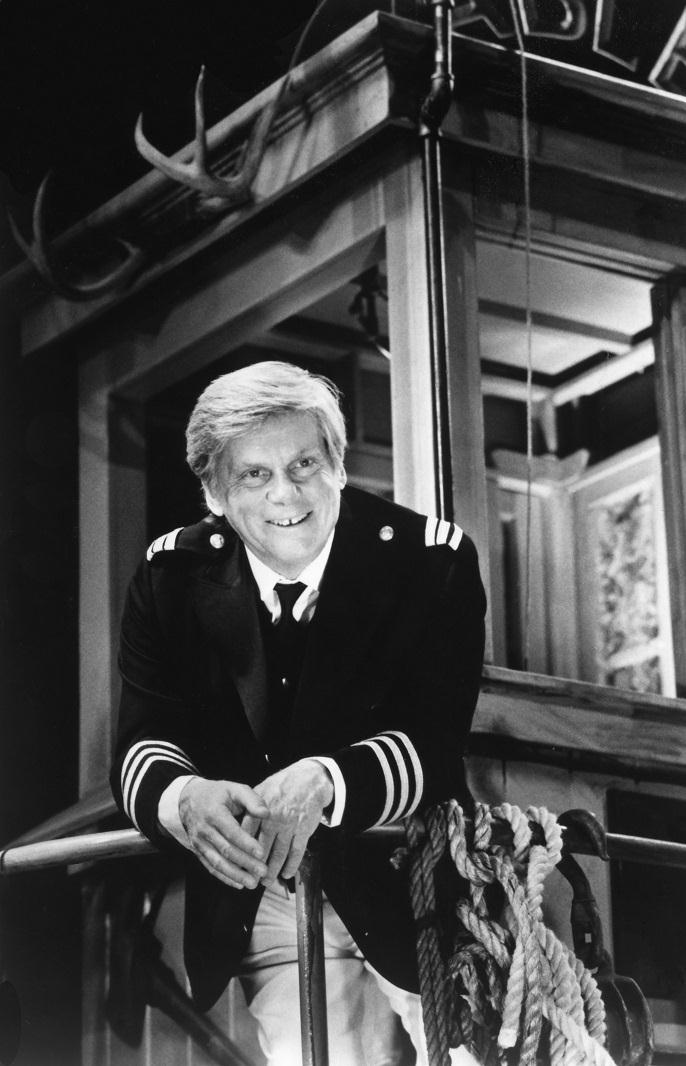
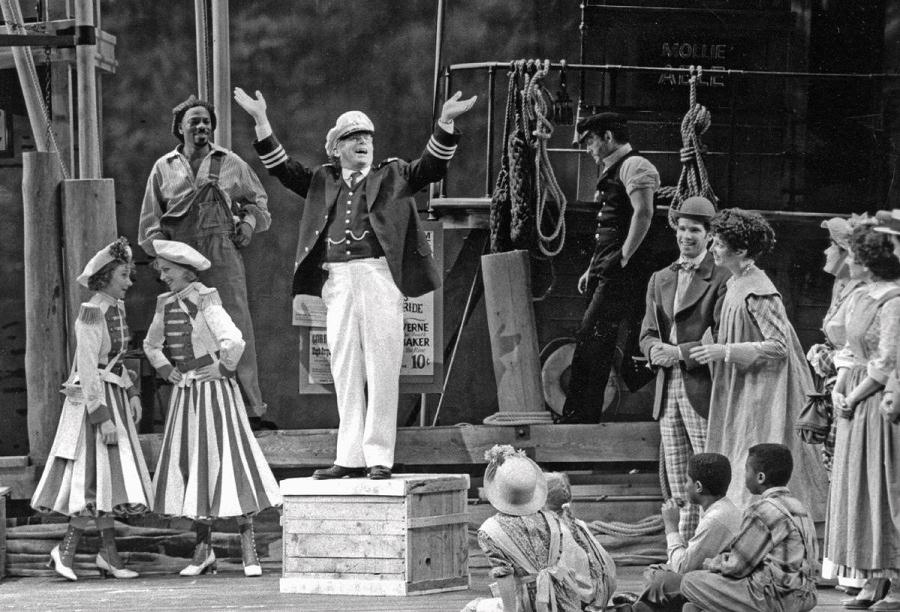
ROBERT MORSE AS "CAP'N ANDY" in the epic 1993 revival of Jerome Kern and Oscar Hammerstein Il's classic musical, "SHOW BOAT," directed by Harold Prince, and featuring a cast of seventy-one actors. Also included Morse performing "Cap'n Andy's Ballyhoo" with cast members looking on.
Produced by Live Entertainment of Canada Inc. and is the inaugural production at the new North York Performing Arts Centre, located in Metropolitan Toronto.
Photo by Catherine Ashmore
The set designer did their research to make the pilot house of the MOLLIE ABLE behind Morse as Andy Hawks by including antlers above the pilot's open front "window" and some "plumbing" that provided steam to the 3 chime whistle. The letters that spell "A B L E" can be seen in the upper right.
Original CAST RECORDING:
Release Date September 26, 1994
Elapsed Time 1:12:53
Recording Date January 24, 1994 - March 6, 1994
Recording Location Manta Eastern Sound Studios, Toronto, Canada
AllMusic Review by Brian Egan
This disc captures the music of the ambitious 1993 staging of Show Boat as the opening attraction of the North York Performing Arts Centre in Toronto. The classic American musical is given new life in this production, as director Harold Prince shapes elements of various past productions into a renewed, more contemporary vision of the show. Orchestrator William David Brohn also revised the show's original orchestrations to suit the new format, but nonetheless remains respectful to Robert Russell Bennett's original. This reworking of Show Boat stands as an important development in the genre of musical theater, and this disc does a commendable job of capturing it for listeners.
Here's another review of the 1993 production of Show Boat in Toronto:
Variety Review
October 1993
SHOW BOAT
by Jeremy Gerard
Music-theater devotees should journey to Toronto for this resplendent and powerful rethinking of "Show Boat," Jerome Kern and Oscar Hammerstein II's 1927 watershed show, directed by Harold Prince and designed by Eugene Lee. With a cast of 68 and a running time of three hours and 15 minutes, only an act of charity will bring this production to Broadway. Yet by virtue of its warmth, its humanity and, not least of all, for the power of "Show Boat," even after nearly seven decades, to raise essential questions about our American nature, this all-star production deserves the widest possible audience.
"Show Boat" begins during the Reconstruction and ends in the Roaring '20s, and the one thing that doesn't change is those signs. So when the protesters argue that cleaning up the language only makes it possible for white people to view the show comfortably, the point resonates. For the 1946 revival, Hammerstein changed the lyric from "nigger" to "colored folk," which is used here, though the word "nigger" surfaces several times in the dialogue.
But questioning theater texts and indeed the social role of theater is exactly what Prince has been doing for most of his career, from the 1970s shows that redefined Broadway -"Company,""Follies,""Pacific Overtures,""Sweeney Todd" and "Evita"- right up to last season's "Kiss of the Spider Woman."
In Prince's hands they were imbued with a powerful social vision, while many of his failures went down because they were more polemical than musical.
Who better, then, to take on "Show Boat," whose very ambivalence about race makes it as contemporary today as it was 66 years ago?
Prince and choreographer Susan Stroman have given the show a sweep that draws the audience almost effortlessly (despite a somewhat static and long first act) across the years.
Their most dazzling conceit is a montage near the end of the show that uses the changing fashion of dance to move the plot from the fin-de-siecle to the flapper era, and it's also here that the production pays homage to the striking ways in which black life permeated American culture.
When the Cotton Blossom steams into view, it's a white clapboard and smoking chimney affair. To outward appearances, there is nothing romantic about Cap'n Andy's floating theater; whatever magic emanates from this boat comes from the people living inside and working on its little stage.
Prince loves theater about theater, and along with everything else it is, "Show Boat" is the granddaddy of backstage musicals.
The production teems with life, and its main characters are extremely well paired and well-played.
Robert Morse plays the henpecked Cap'n Andy, stabbing the air with his hands in frustration or triumph at Elaine Stritch's hard, hard Parthy; vocally, they are sandpaper against sandpaper.
Rebecca Luker and Mark Jacoby play Magnolia and Gaylord rather like Fanny Brice and Nick Arnstein, and she is much his superior in the singing department. As the comic couple, Dorothy Stanley and Joel Blum are charming and loose-limbed.
Lonette McKee played Julie in the Houston Grand Opera production that ran briefly on Broadway 10 years ago; her voice is every bit as gorgeous now as it was then, and she's a better actress.
Other revelations are Gretha Boston's dignified Queenie — for whom Prince restored "Mis'ry's Comin' Aroun,' " a majestic song cut from the original) and Michel Bell's Joe, whose "Ol' Man River" fills the space and then some.
The production is exquisitely lit by Richard Pilbrow, and Florence Klotz's costumes are knockouts.
A "Show Boat" that faithfully recreated Florenz Ziegfeld's original production would probably provoke riots today. But Prince and company have mounted a persuasive argument for the show's humane spirit with minimal sleight-of-hand. "One forgets the clock," Variety reported in its original review. It was true then, and it's true today.
Show Boat
Mainstage Theater
North York Performing Arts Center Toronto
Production:
A Live Entertainment of Canada presentation of a musical in two acts
music by Jerome Kern
book and lyrics by Oscar Hammerstein II
based on the novel by Edna Ferber
Directed by Harold Prince
choreography by Susan Stroman
Cast:
Steve - Doug LaBrecque
Queenie - Gretha Boston
Parthy - Elaine Stritch
Windy - Ralph Williams
Cap'n Andy - Robert Morse
Ellie - Dorothy Stanley
Frank - Joel Blum
Julie - Lonette McKee
Gaylord Ravenal - Mark Jacoby
Magnolia - Rebecca Luker
Joe - Michel Bell
Kim - Tammy Amerson
Also with:
David Bryant, Michael Fletcher, Lawrence Cotton, Gordon McLaren, Mike O'Carroll, Amanda Nanfo, Danielle Greaves, Lorraine Foreman and Sheila Smith.
Crew:
Sets, Eugene Lee
costumes, Florence Klotz
lighting, Richard Pilbrow
sound, Martin Levan
musical supervision and conductor, Jeffrey Huard
orchestrations, Robert Russell Bennett and William David Brohn.
Opened and reviewed Oct. 17, 1993.

With the exception of images credited to public institutions,
everything on this page is from a private collection.
Please contact Steamboats.com for permission for commercial use.*
All captions provided by Dave Thomson, Steamboats.com primary contributor and historian.
